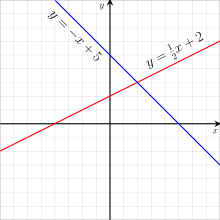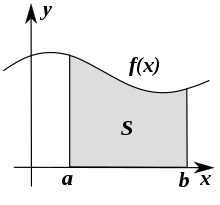Linear function
Inmathematics,the termlinear functionrefers to two distinct but related notions:[1]
- Incalculusand related areas, a linear function is afunctionwhosegraphis astraight line,that is, apolynomial functionofdegreezero or one.[2]For distinguishing such a linear function from the other concept, the termaffine functionis often used.[3]
- Inlinear algebra,mathematical analysis,[4]andfunctional analysis,a linear function is alinear map.[5]
As a polynomial function[edit]

In calculus,analytic geometryand related areas, a linear function is a polynomial of degree one or less, including thezero polynomial(the latter not being considered to have degree zero).
When the function is of only onevariable,it is of the form
whereaandbareconstants,oftenreal numbers.Thegraphof such a function of one variable is a nonvertical line.ais frequently referred to as the slope of the line, andbas the intercept.
Ifa > 0then thegradientis positive and the graph slopes upwards.
Ifa < 0then thegradientis negative and the graph slopes downwards.
For a functionof any finite number of variables, the general formula is
and the graph is ahyperplaneof dimensionk.
Aconstant functionis also considered linear in this context, as it is a polynomial of degree zero or is the zero polynomial. Its graph, when there is only one variable, is a horizontal line.
In this context, a function that is also a linear map (the other meaning) may be referred to as ahomogeneouslinear function or alinear form.In the context of linear algebra, the polynomial functions of degree 0 or 1 are the scalar-valuedaffine maps.
As a linear map[edit]

In linear algebra, a linear function is a mapfbetween twovector spacessuch that
Hereadenotes a constant belonging to somefieldKofscalars(for example, thereal numbers) andxandyare elements of avector space,which might beKitself.
In other terms the linear function preservesvector additionandscalar multiplication.
Some authors use "linear function" only for linear maps that take values in the scalar field;[6]these are more commonly calledlinear forms.
The "linear functions" of calculus qualify as "linear maps" when (and only when)f(0,..., 0) = 0,or, equivalently, when the constantbequals zero in the one-degree polynomial above. Geometrically, the graph of the function must pass through the origin.
See also[edit]
- Homogeneous function
- Nonlinear system
- Piecewise linear function
- Linear approximation
- Linear interpolation
- Discontinuous linear map
- Linear least squares
Notes[edit]
- ^"The termlinear functionmeans a linear form in some textbooks and an affine function in others. "Vaserstein 2006, p. 50-1
- ^Stewart 2012, p. 23
- ^A. Kurosh (1975).Higher Algebra.Mir Publishers. p. 214.
- ^T. M. Apostol (1981).Mathematical Analysis.Addison-Wesley. p. 345.
- ^Shores 2007, p. 71
- ^Gelfand 1961
References[edit]
- Izrail Moiseevich Gelfand (1961),Lectures on Linear Algebra,Interscience Publishers, Inc., New York. Reprinted by Dover, 1989.ISBN0-486-66082-6
- Thomas S. Shores (2007),Applied Linear Algebra and Matrix Analysis,Undergraduate Texts in Mathematics,Springer.ISBN0-387-33195-6
- James Stewart (2012),Calculus: Early Transcendentals,edition 7E, Brooks/Cole.ISBN978-0-538-49790-9
- Leonid N. Vaserstein (2006), "Linear Programming", inLeslie Hogben,ed.,Handbook of Linear Algebra,Discrete Mathematics and Its Applications, Chapman and Hall/CRC, chap. 50.ISBN1-584-88510-6





